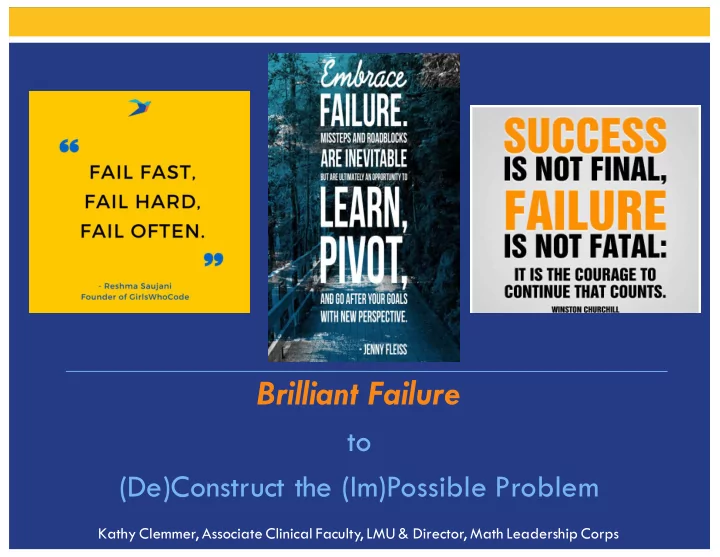

Brilliant Failure to (De)Construct the (Im)Possible Problem Kathy Clemmer, Associate Clinical Faculty, LMU & Director, Math Leadership Corps
How do you imagine mathematics? 2
Doing Mathematics means • Seeking and studying Patterns • Finding Multiple Representations • Using Inductive and Deductive Reasoning 3
Where do we integrate purposeful failure? 4 https://www.youtube.com/watch?v=pobLgR6UV5g
Why Brilliant Failure versus Failure? 5
7 Bridges of Konigsberg Problem: • Start on land or bridge, you choose • Find path where you cross a bridge only once (no backtracking) • Cannot walk on water, or “go around” the river What does your brain do when you hit your first obstacle? Second obstacle? 6
Brilliant Failure The “what if…” thought that causes you to go back and approach the problem from a different perspective. 7
Question prompts to support pair problem solving dialogue around “what if…” thoughts • What ( exactly ) are you doing? • Can you describe ____ precisely? • Why are we doing _______? • How does ____ fit into the solution? • How does ____ help us with _____? • What will we do with _______when we obtain it? 8 Schoenfeld, A. H. (1985). Mathematical Problem Solving. Orlando, FL : Academic Press.
I’m stuck what if... What if we blow up a What if we build another bridge to work with 6 bridge to work with 8 bridges instead of 7? bridges instead of 7? 9
Study of Patterns CCSS Math Practice 8 : Look for and express regularity in repeated reasoning. Generalization = Short Cut Trick Short Cut vs. CCSS Math Practice 7: Look for and make use of structure. 10
Problem: Arrange these 6 pencils to create 4 equilateral triangles Seek your “what if….” 11
Question prompts to support pair problem solving dialogue around “what if…” thoughts • What ( exactly ) are you doing? • Can you describe ____ precisely? • Why are we doing _______? • How does ____ fit into the solution? • How does ____ help us with _____? • What will we do with _______when we obtain it? 12 Schoenfeld, A. H. (1985). Mathematical Problem Solving. Orlando, FL : Academic Press.
How do we scaffold Brilliant Failure and problem solving dialogues? Strategic Clue: CCSS Math Practice 2 : Reason abstractly and quantitatively. 13
Multiple Representations CCSS Math Practice 4: Model with mathematics. Map relationships using such tools as diagrams, two-way tables, graphs, flowcharts, and formulas CCSS Math Practice 5: Use appropriate tools strategically. Example of a “tool” : logarithms 14
Logarithms simplify difficult calculations A real result of Brilliant Failure Gregoire de Saint Vincent’s “what if….” In an attempt to perform a quadrature of a rectangular hyperbola Gregoire discovered the natural logarithm 15
Once we figure out a “what if…” that appears to work, we need to figure out... 16 https://www.youtube.com/watch?v=RRq7lLawQB4
Mathematical Proof Inductive & Deductive Reasoning Mathematical Proof : Develop a tightly knit chain of reasoning , following strict logical rules, that leads inexorably to the absolute truth . CCSS Math Practice 3: Construct viable arguments & critique the reasoning of others. CCSS Math Practice 6: Attend to precision. 17
Doing Mathematics and seeking Brilliant Failure Can we prove that every even whole number greater than 2 can always be written as the sum of two primes? Seeking my Brilliant Failure , my “what if…” thought that causes me to go back and approach the problem from a different perspective. 18
GoldbachConjecture In 1742, Christian Goldbach came to the following conclusion: It seems that every even number greater than 2 can indeed be written as the sum of two primes . He communicated his idea to Leonhard Euler who regarded the result as trivial. However, the Goldbach Conjecture remains unproven to this day. Unsolved Problems: A reason for teaching “what if…..” 19
Role of Brilliant Failure in Doing & Thinking Through Mathematics MP 1: Make sense of problems and persevere in solving them. of Patterns MP 7: Look for and make use of structure. Study MP 8: Look for and express regularity in repeated reasoning. Representations MP 2: Reason abstractly and quantitatively. Multiple MP 4: Model with mathematics. MP 5: Use appropriate tools strategically. MP 3: Construct viable arguments and critique the Inductive & Deductive reasoning of others. MP 6: Attend to precision. 20
A Roadmap for Instruction that Promotes Mathematical Thinking & Problem Solving 21
We use Brilliant Failure to (De)Construct the (Im)Possible Problem every day as teachers… 22 https://www.youtube.com/watch?v=SFnMTHhKdkw
Questions? Kathy Clemmer, Associate Clinical Faculty, LMU & Director, Math Leadership Corps Email: kclemmer@lmu.edu
Recommend
More recommend